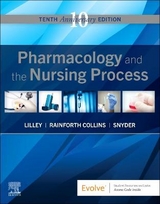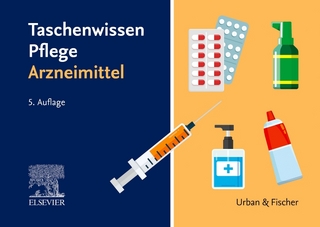
Pharmacology and the Nursing Process
Mosby (Verlag)
978-0-323-52949-5 (ISBN)
- Titel erscheint in neuer Auflage
- Artikel merken
Focus on need-to-know content uses a "key drug" approach to help you focus on the most important information.
Focus on the nursing process helps you learn to prioritize nursing care to focus on the most essential assessments, nursing diagnoses, interventions, and evaluation/outcome criteria.
Focus on prioritization includes prioritized nursing diagnoses along with corresponding prioritization of goals and outcomes, to help you learn to connect nursing diagnoses to goals and outcomes.
Additional QSEN coverage incorporates more QSEN information throughout the text.
Applicable QSEN competencies added to text case study titles
Collaboration and teamwork content added to selected case studies
Addition of new Safety: What Went Wrong? case studies
Explanation of QSEN initiatives as it relates to safety and quality of patient care is included in the Medication Errors chapter
Improved readability is aided by more friendly, direct-address language; shorter sentences; simplified language (where appropriate); and much more.
An extensive Photo Atlas of Drug Administration features more than 100 step-by-step illustrations depicting key steps in drug administration for various routes of drug administration.
UNIQUE! QSEN focus highlights those aspects of the book - such as boxes, tips, case studies, and other content - that correlate with the QSEN competencies.
Popular key drug approach focuses on the need-to-know content for safe clinical practice and uses a streamlined approach to drug indications, emphasizing only the most common or serious adverse effects.
Integrated NCLEX® Examination preparation includes seven NCLEX Examination review questions in every chapter, with at least one alternate-format item per chapter.
Thorough application of the nursing process is addressed in each chapter to help you learn how to prioritize nursing care to focus on the most essential assessments, nursing diagnoses, interventions, and evaluation/outcome criteria.
Colorful and consistent learner-friendly format utilizes a variety of tables and practical body systems organization to help you integrate pharmacology content with what you are learning in medical-surgical and adult health nursing courses.
Large collection of student-friendly learning aids includes approachable text elements such as:
Cartoon-illustrated learning strategies covering study, time management, and test-taking tips related to studying pharmacology.
Drug profiles highlighting specific information on commonly-used agents.
Case studies that help bring patients to life and promote critical thinking skills.
Dosages tables providing instant access to dosages, routes, and indications for individual drugs.
Key points summarizing key pharmacology and nursing content in each chapter.
Critical thinking and prioritization questions encourage you to think on a deeper level.
More than 250 full-color photos and illustrations show how drugs work in the body and how to administer medications safely and effectively.
NEW! Thoroughly updated drug content reflects the very latest FDA drug approvals, withdrawals, and therapeutic uses, as well as corresponding updated nursing content
NEW! UNIQUE! Many new images in Photo Atlas of Drug Information included to accompany difficult concepts.
NEW! Inclusion of more student practice questions helps you better comprehend complex concepts.
Linda Lilley, RN, PhD, is University Professor and Associate Professor Emeritus at the School of Nursing at Old Dominion University in Norfolk, Virginia. Shelly Collins, PharmD, has decades of clinical experience in which she has been responsible for overseeing system-wide pharmaceutical safety. Julie S. Snyder, MSN, RN-BC, teaches at the School of Nursing at Old Dominion University in Norfolk, Virginia and works in the clinical field as well, enabling her to bring comprehensive insight to the book.
PART 1: PHARMACOLOGY BASICS 1. The Nursing Process and Drug Therapy 2. Pharmacologic Principles 3. Lifespan Considerations 4. Cultural, Legal, and Ethical Considerations 5. Medication Errors: Preventing and Responding 6. Patient Education and Drug Therapy 7. Over-the-Counter Drugs and Herbal and Dietary Supplements 8. Gene Therapy and Pharmacogenomics 9. Photo Atlas of Drug Administration
PART 2: DRUGS AFFECTING THE CENTRAL NERVOUS SYSTEM 10. Analgesic Drugs 11. General and Local Anesthetics 12. Central Nervous System Depressants and Muscle Relaxants 13. Central Nervous System Stimulants and Related Drugs 14. Antiepileptic Drugs 15. Antiparkinson Drugs 16. Psychotherapeutic Drugs 17. Substance Use Disorder
PART 3: DRUGS AFFECTING THE AUTONOMIC NERVOUS SYSTEM 18. Adrenergic Drugs 19. Adrenergic-Blocking Drugs 20. Cholinergic Drugs 21. Cholinergic-Blocking Drugs
PART 4: DRUGS AFFECTING THE CARDIOVASCULAR AND RENAL SYSTEMS 22. Antihypertensive Drugs 23. Antianginal Drugs 24. Heart Failure Drugs 25. Antidysrhythmic Drugs 26. Coagulation Modifier Drugs 27. Antilipemic Drugs 28. Diuretic Drugs 29. Fluids and Electrolytes
PART 5: DRUGS AFFECTING THE ENDOCRINE AND REPRODUCTIVE SYSTEMS 30. Pituitary Drugs 31. Thyroid and Antithyroid Drugs 32. Antidiabetic Drugs 33. Adrenal Drugs 34. Women's Health Drugs 35. Men's Health Drugs
PART 6: DRUGS AFFECTING THE RESPIRATORY SYSTEM 36. Antihistamines, Decongestants, Antitussives, and Expectorants 37. Respiratory Drugs
PART 7: ANTIINFECTIVE AND ANTIINFLAMMATORY DRUGS 38. Antibiotics Part 1 39. Antibiotics Part 2 40. Antiviral Drugs 41. Antitubercular Drugs 42. Antifungal Drugs 43. Antimalarial, Antiprotozoal, and Anthelmintic Drugs 44. Antiinflammatory and Antigout Drugs
PART 8: CHEMOTHERAPEUTIC DRUGS AND BIOLOGIC AND IMMUNE MODIFIERS 45. Antineoplastic Drugs Part 1: Cancer Overview and Cell Cycle-Specific Drugs 46. Antineoplastic Drugs Part 2: Cell Cycle-Nonspecific Drugs and Miscellaneous Drugs 47. Biologic Response-Modifying and Antirheumatic Drugs 48. Immunosuppressant Drugs 49. Immunizing Drugs
PART 9: DRUGS AFFECTING THE GASTROINTESTINAL SYSTEM AND NUTRITION 50. Acid-Controlling Drugs 51. Bowel Disorder Drugs 52. Antiemetic and Antinausea Drugs 53. Vitamins and Minerals 54. Anemia Drugs 55. Nutritional Supplements
PART 10: DERMATOLOGIC, OPHTHALMIC, AND OTIC DRUGS 56. Dermatologic Drugs 57. Ophthalmic Drugs 58. Otic Drugs
Appendix: Pharmaceutical Abbreviations
Index
| Erscheinungsdatum | 12.03.2019 |
|---|---|
| Zusatzinfo | Approx. 560 illustrations (560 in full color); Illustrations |
| Verlagsort | St Louis |
| Sprache | englisch |
| Maße | 306 x 234 mm |
| Gewicht | 1900 g |
| Themenwelt | Medizin / Pharmazie ► Pflege ► Ausbildung / Prüfung |
| ISBN-10 | 0-323-52949-6 / 0323529496 |
| ISBN-13 | 978-0-323-52949-5 / 9780323529495 |
| Zustand | Neuware |
| Haben Sie eine Frage zum Produkt? |
aus dem Bereich



